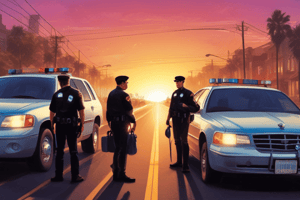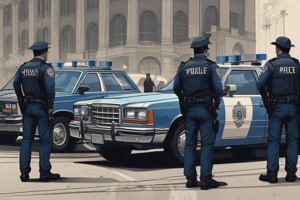Podcast
Questions and Answers
No vehicle, marked or unmarked, shall be operated in an emergency response mode unless specifically authorized.
No vehicle, marked or unmarked, shall be operated in an emergency response mode unless specifically authorized.
True (A)
What are the two types of emergency response?
What are the two types of emergency response?
Code 3 Emergency and Code 2 Emergency
Emergency response is the operation of a police vehicle with all emergency equipment activated, in response to authorized information that an actual emergency _______.
Emergency response is the operation of a police vehicle with all emergency equipment activated, in response to authorized information that an actual emergency _______.
exists
What is a Code 3 Emergency?
What is a Code 3 Emergency?
Which vehicles are granted exemptions from certain traffic laws during an emergency response?
Which vehicles are granted exemptions from certain traffic laws during an emergency response?
During an emergency response, vehicle operators are immune from liability.
During an emergency response, vehicle operators are immune from liability.
What is a Routine Response?
What is a Routine Response?
What must be activated during an emergency response?
What must be activated during an emergency response?
A vehicle must be authorized by radio signal or a supervisor to operate in an emergency response mode.
A vehicle must be authorized by radio signal or a supervisor to operate in an emergency response mode.
What are the two types of emergency response?
What are the two types of emergency response?
What are three primary elements that must be considered during an emergency response?
What are three primary elements that must be considered during an emergency response?
When can police officers exceed the posted speed limit during an emergency response?
When can police officers exceed the posted speed limit during an emergency response?
Emergency signal devices must be activated day or night when responding to an __________.
Emergency signal devices must be activated day or night when responding to an __________.
Police officers can activate emergency signal devices without authorization in all situations.
Police officers can activate emergency signal devices without authorization in all situations.
What is a routine response?
What is a routine response?
What actions must police personnel observe when responding to routine calls?
What actions must police personnel observe when responding to routine calls?
Flashcards are hidden until you start studying
Study Notes
General Guidelines
- Only operate emergency vehicles with authorization from a supervisor or radio signal.
- Vehicles must be equipped with visible and audible emergency signal devices during emergency responses.
- Exemptions from traffic laws are granted under Florida Statutes for emergency vehicles but require due regard for public safety.
- Normal traffic enforcement vehicles must be appropriately marked and equipped with red and blue lights, siren, and public address systems.
Response Modes
- Emergency Response: Involves activation of all emergency equipment in response to an actual or believed emergency.
- Types of emergencies:
- Code 3: Immediate threat to life requiring swift action (e.g., serious injuries, shootings).
- Code 2: Potential threat requiring swift action (e.g., assaults, hazardous spills).
- Types of emergencies:
- Key Considerations for Emergency Response:
- Prioritize safety, expedient arrival, and life/property protection.
- Operators are liable for negligent vehicle operation or reckless behavior.
- Generally, only authorized personnel should respond to emergency signals, unless initiated by supervisors.
Emergency Signal Activations
- Code 3 responses may exceed speed limits by up to 20 mph; Code 2 may exceed by up to 10 mph.
- Emergency signal devices must be active when responding and can be deactivated at a safe distance from the incident scene.
- Vehicle operators must obey traffic rules when not using emergency signals.
Back-Up Units
- Designated by dispatchers or supervisors; officers nearby may request to be designated.
- Backup unit signals (2-15 for Code 2 and 3-15 for Code 3) must be maintained for safe coordination.
- First unit to arrive on scene must report conditions for further responses.
Discretionary Activation of Emergency Signals
- Officers can request permission to activate signals under serious incident awareness.
- Signals may be used to manage traffic flow in hazardous situations but must follow traffic laws.
- Emergency signals may be activated during normal traffic enforcement if necessary.
Routine Response
- Involves operating a police vehicle without emergency signals in non-threatening situations.
- Routine calls lack tone indicators and must be handled under normal traffic conditions.
- Officers must adhere to speed limits and traffic control devices during routine responses.
General Guidelines
- Only operate emergency vehicles with authorization from a supervisor or radio signal.
- Vehicles must be equipped with visible and audible emergency signal devices during emergency responses.
- Exemptions from traffic laws are granted under Florida Statutes for emergency vehicles but require due regard for public safety.
- Normal traffic enforcement vehicles must be appropriately marked and equipped with red and blue lights, siren, and public address systems.
Response Modes
- Emergency Response: Involves activation of all emergency equipment in response to an actual or believed emergency.
- Types of emergencies:
- Code 3: Immediate threat to life requiring swift action (e.g., serious injuries, shootings).
- Code 2: Potential threat requiring swift action (e.g., assaults, hazardous spills).
- Types of emergencies:
- Key Considerations for Emergency Response:
- Prioritize safety, expedient arrival, and life/property protection.
- Operators are liable for negligent vehicle operation or reckless behavior.
- Generally, only authorized personnel should respond to emergency signals, unless initiated by supervisors.
Emergency Signal Activations
- Code 3 responses may exceed speed limits by up to 20 mph; Code 2 may exceed by up to 10 mph.
- Emergency signal devices must be active when responding and can be deactivated at a safe distance from the incident scene.
- Vehicle operators must obey traffic rules when not using emergency signals.
Back-Up Units
- Designated by dispatchers or supervisors; officers nearby may request to be designated.
- Backup unit signals (2-15 for Code 2 and 3-15 for Code 3) must be maintained for safe coordination.
- First unit to arrive on scene must report conditions for further responses.
Discretionary Activation of Emergency Signals
- Officers can request permission to activate signals under serious incident awareness.
- Signals may be used to manage traffic flow in hazardous situations but must follow traffic laws.
- Emergency signals may be activated during normal traffic enforcement if necessary.
Routine Response
- Involves operating a police vehicle without emergency signals in non-threatening situations.
- Routine calls lack tone indicators and must be handled under normal traffic conditions.
- Officers must adhere to speed limits and traffic control devices during routine responses.
Studying That Suits You
Use AI to generate personalized quizzes and flashcards to suit your learning preferences.



